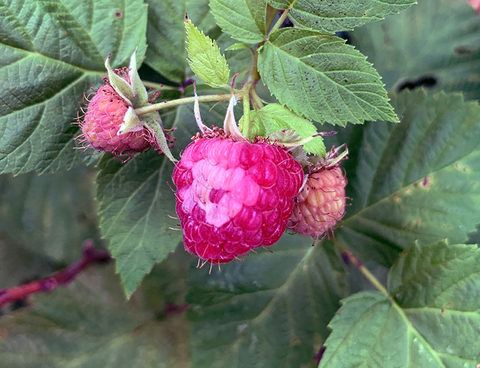Sunburn or sunscald
Summer days with strong sunlight may cause sunscald on berries. This causes berries that are white or colorless on the surface directly exposed to the sun. The white drupelets will be flavorless, but there is no harm in eating them.
Heat damage
Extreme or ongoing high heat during fruit development and ripening can cause the berries to be more crumbly, dry, and less flavorful.
Heat damage is very difficult to avoid if extreme heat occurs. You could experiment with using shade cloth over the rows to attempt to lower the canopy temperature.
Once the weather cools, plants will go back to producing normal berries.
Small fruit and low yields
Potential causes of small fruit or low yields include:
- Insufficient irrigation - test the soil moisture before deciding whether to increase irrigation.
- Drought.
- Nutrient deficiency or low/high soil pH - a soil and foliar test should be performed to identify necessary nutrient amendments.
- Low or high irrigation water pH - submit water samples for testing.
- Raspberry patch is getting old and starting to decline.
- Raspberry patch is too crowded and needs more extensive pruning.
- Poor pollination due to heat or low pollinator populations.
Try to diagnose the problem before implementing changes. Trying to increase irrigation or fertilizer can cause more problems than it solves if water and nutrients were already adequate.
Winter injury
Winter injury is most common on floricane-bearing varieties. The overwintering floricanes are exposed to extreme temperatures as they are usually taller than even the highest snow levels.
Winter injury is often confused with cane blight, but it has symptoms that are different from other diseases.
Identifying winter injury:
- The tips of the canes are most susceptible to winter cold.
- Mild winter injury will result in the death of the top few inches of a cane.
- With severe winter injury, the top few feet of the canes will die.
- In almost all cases of winter injury, there will be healthy leaves at the bottom of the cane.
- If the winter injury occurred with a few inches of snow, then the canes die to snow level and will produce healthy leaves and fruit from the lower canes that were covered by the snow.
Even cold-hardy varieties can exhibit symptoms of winter injury following severe winters. Winter injury can also occur after winters when the temperature fluctuates between mild and extremely cold, or in high tunnels that remain covered in plastic over the winter.
Dieback in the primocanes of fall-bearing raspberries is normal and is not considered winter injury.
Flowering in primocanes always starts at the tips of the canes and later flowers sprout lower in the cane. Any part of the cane that produces flowers will die in the winter. Always choose varieties that are suitable for your USDA hardiness zone in Minnesota.
Reviewed in 2022


